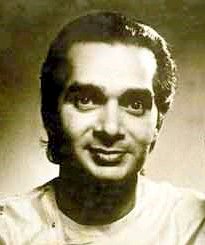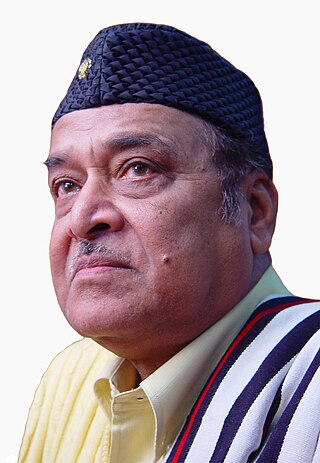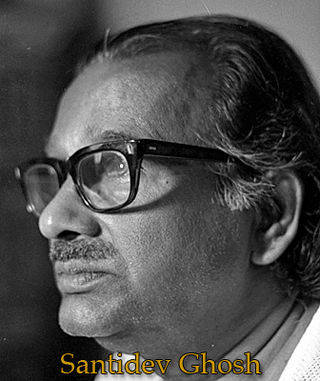
Jogesh Dutta (born 1935) is an Indian mime [1] who for over fifty years, pioneered the art of mime in India.

Jogesh Dutta (born 1935) is an Indian mime [1] who for over fifty years, pioneered the art of mime in India.
Born in 1935 in Faridpur District of Bangladesh, Datta spent almost 11 years of his life in his native village at Haatshiruaail. When India awoke to a ‘new dawn’ on 15 August 1947, a 15-year-old boy, his parents and five siblings found themselves on a platform at Calcutta’s Sealdah railway station. Penniless refugees from East Pakistan, the family, like lakhs of others, faced a dark future; soon an orphan at the mercy of distant relatives, he washed dishes at a tea stall, was a grocer’s assistant and worked at a construction site before finding his true calling. While his inspiration was Charlie Chaplin, Jogesh keenly observed young couples snatching a few private moments on the banks of a lake in the city and started imitating them, much to the delight of his friends and associates. In 1956, he created his first real mime act—a lady dressing up in front of a mirror. The same year, he regaled spectators with this, in what was also his first stage mime performance, at Bally near Kolkata. Initially a comic and an actor, Jogesh was a founder-member of Sundaram and acted in two early plays: Pather Panchali and Mrityur Chokhe Jol [2] (1959) by Manoj Mitra. [3] Learning by himself, Jogesh was unaware of the traditions of mime or the ancient Natyashastra . [2] Dutta considered 1960 his breakthrough year when performances at the National Youth Festival in Calcutta led to a flow of invitations to perform from all over the country and later the world. [4]
As an exponent of Indian culture he has circled the globe several times, bringing a tribute from abroad several times including U.K., u.s.a., U.S.S.R., Germany, France, Czechoslovakia, Romania, Bulgaria, Holland, Afghanistan, the Middle East, Canada, etc. He was a delegate to the 9th World Festival of Youth and Students in Sofia (Bulgaria) in 1968. He was awarded as a performing artiste at the 10th world fair held in G.D.R. in 1973. [5] The Films Division made a documentary on him in 14 Indian languages in 1983; further documentaries were made by Germany, Britain and France. [4]
He formed his troupe Podaboli in 1971 that became the Jogesh Mime Akademi in 1975 with the help of the Bengal government; it is affiliated with the Sangeet Natak Akademi and Rabindra Bharati University. There he imparts his talents and technique to budding artists such as he once was, having retired from the stage in 2009. It has a four-year course that has students from India, Bangladesh, Nepal and Switzerland. Dutta’s Silent Village for the physically challenged has mime as an optional vocation. [2]
Dutta’s final appearance on stage was in his hugely popular The Thief at the Rabindra Sadan in 2009. [2] "I’m old and can’t take the rigours of staging an act anymore. Mime shows require agility and swift physical movement and that’s becoming difficult for me," he said. Jogesh reappeared after his final show on stage, dressed in white shirt and trousers, and laid his wig and costume on the floor. As the ‘poet of silence’ he didn’t utter a word. To those who clamoured for the show to go on, he assured that he would continue to teach mime. And thus, mime will live on. [4]

The music of West Bengal includes multiple indigenous musical genres such as Baul, Ramprasadi, Bishnupuri Classical, Kirtan, Shyama Sangeet, Rabindra Sangeet, Nazrul Geeti, Dwijendrageeti, Prabhat Samgiita, Agamani-Vijaya, Patua Sangeet, Gambhira, Bhatiali, Bhawaiya, Bengali Rock.

Uday Shankar was an Indian dancer and choreographer, best known for creating a fusion style of dance, adapting European theatrical techniques to Indian classical dance, imbued with elements of Indian classical, folk, and tribal dance, which he later popularised in India, Europe, and the United States in 1920s and 1930s. He was a pioneer of modern dance in India.

SoumitraChatterjee was an Indian film actor, play-director, playwright, writer, thespian and poet. He is regarded as one of the greatest and most influential actors in the history of Indian cinema. He is best known for his collaborations with director Satyajit Ray, with whom he worked in fourteen films.

Utpal Dutta was an Indian actor, director, and writer-playwright. He was primarily an actor in Bengali theatre, where he became a pioneering figure in Modern Indian theatre, when he founded the "Little Theatre Group" in 1949. This group enacted many English, Shakespearean and Brecht plays, in a period now known as the "Epic theatre" period, before it immersed itself completely in highly political and radical theatre. His plays became an apt vehicle for the expression of his Marxist ideologies, visible in socio-political plays such as Kallol (1965), Manusher Adhikar, Louha Manob (1964), Tiner Toloar and Maha-Bidroha. He also acted in over 100 Bengali and Hindi films in a career spanning 40 years, and remains most known for his roles in films such as Mrinal Sen’s Bhuvan Shome (1969), Satyajit Ray’s Agantuk (1991), Gautam Ghose’s Padma Nadir Majhi (1993) and Hrishikesh Mukherjee's breezy Hindi comedies such as Gol Maal (1979) and Rang Birangi (1983). He also did the role of a sculptor, Sir Digindra Narayan, in the episode Seemant Heera of Byomkesh Bakshi on Doordarshan in 1993, shortly before his death.

Bhupen Hazarika BR was an Indian playback singer, lyricist, musician, poet, actor, filmmaker and politician from Assam, widely known as Sudha Kontho. His songs were written and sung mainly in the Assamese language by himself, are marked by humanity and universal brotherhood and have been translated and sung in many languages, most notably in Bengali and Hindi.

Suchitra Mitra was an Indian singer, composer, artist exponent of Rabindra Sangeet or the songs of Bengal's poet laureate Rabindranath Tagore, professor, and the first woman Sheriff of Kolkata. As an academic, she remained a professor and the Head of Rabindra Sangeet Department at the Rabindra Bharati University for many years. Mitra was a playback singer in Bengali films and was associated for many years with the Indian People's Theatre Association.
Sombhu Mitra was an Indian film and stage actor, director, playwright, reciter and an Indian theatre personality, known especially for his involvement in Bengali theatre, where he is considered a pioneer. He remained associated with the Indian People's Theatre Association (IPTA) for a few years before founding the Bohurupee theatre group in Kolkata in 1948. He is most noted for films like Dharti Ke Lal (1946), Jagte Raho (1956), and his production of Rakta Karabi based on Rabindranath Tagore's play in 1954 and Chand Baniker Pala, his most noted play as a playwright.

Sudhindra Sircar, also known as Badal Sarkar, was an influential Indian dramatist and theatre director, most known for his anti-establishment plays during the Naxalite movement in the 1970s and taking theatre out of the proscenium and into public arena, when he transformed his own theatre company, Shatabdi as a third theatre group. He wrote more than fifty plays of which Ebong Indrajit, Basi Khabar, and Saari Raat are well known literary pieces. A pioneering figure in street theatre as well as in experimental and contemporary Bengali theatre with his egalitarian "Third Theatre", he prolifically wrote scripts for his Aanganmanch performances, and remains one of the most translated Indian playwrights. Though his early comedies were popular, it was his angst-ridden Evam Indrajit that became a landmark play in Indian theatre. Today, his rise as a prominent playwright in 1960s is seen as the coming of age of Modern Indian playwriting in Bengali, just as Vijay Tendulkar did it in Marathi, Mohan Rakesh in Hindi, and Girish Karnad in Kannada.

Rudraprasad Sengupta is a Bengali Indian actor, director and cultural critic.

Santidev Ghose was an Indian author, singer, actor, dancer and maestro of Rabindra Sangeet.
Pandit Jnan Prakash Ghosh often known as 'Guru' Jnan Prakash Ghosh was an Indian harmonium and tabla player from Farukhabad gharana of Hindustani classical music and musicologist.

Shyamanand Jalan was a Kolkata-based Indian theatre director, and actor. He is credited for the renaissance period of modern Indian theatre and especially the Hindi theatre in Kolkata from the 1960s to 1980s. He was the first to perform modernist Mohan Rakesh, starting with Ashadh Ka Ek Din in 1960 and in the coming years bridged the gap between Hindi theatre and Bengali theatre, by mounting Hindi productions of works by Bengali playwrights, like Badal Sircar's Evam Indrajit (1968) and Pagla Ghora (1971), which in turn introduced Sircar to rest of the country. In 2005, he directed his first and only film Eashwar Mime Co., which was an adaptation of Dibyendu Palit's story, Mukhabhinoy, by Vijay Tendulkar.

Manoj Mitra is an Indian theatre, film and television actor, director and playwright.
Khaled Choudhury was a theatre personality and artist of Bengal. He worked for various directors of both Bengali and Hindi plays, including Sombhu Mitra, Tripti Mitra, and Shyamanand Jalan in various capacities — creating the Stage, sets and costumes and later as music director. He was a bachelor. He has been awarded the Padma Bhushan for his contribution to theatre in India's Republic Day Honours List on 26 January 2012. He died on 30 April 2014 in Kolkata.
Tapas Sen was a noted Indian stage lighting designer, who was an important figure in 20th-century Indian theatre. He started working with Bengali theatre movement in Kolkata in the late 1940s, along with noted directors, Utpal Dutt and Shambhu Mitra. Later he became a founding member of the Indian People's Theatre Association's (IPTA), Delhi chapter, and worked closely with Hindi theatre. Through his career stretching five decades he worked theatre directors, Ebrahim Alkazi, Vijay Tendulkar, and also dancers Sadhana Bose, Chandralekha, Birju Maharaj and Kelucharan Mahapatra. He was known not only for his creative stage lighting, but also had a significant impact on the work of leading theatre director of the time.
Gopeshwar Banerjee or Gopeshwar Bandopadhyay (1880–1963) was an Indian classical singer and musicologist, belonging to Bishnupur gharana of Hindustani music, which originated in Bishnupur in West Bengal. He was known for his khyal and dhrupad renditions, besides Rabindra Sangeet. He also sang thumri, and most notably the thumri, Kon Gali Gayo Shyam, in Raga Mishra Khamaj, which he popularised. As a musicologist, he published several books of rare compositions with musical notations, including dhrupad and Rabindra Sangeet.
Ahindra Choudhury (1896-1974) was an Indian actor, director, theatre personality and the co-founder of Photo Play Syndicate, a Kolkata-based art organization for bioscope shows. A winner of the Sangeet Natak Akademi Award in 1958, Choudhury was honoured by the Government of India in 1963 with the award of Padma Shri, the fourth highest Indian civilian award, for his services to the nation.

Sabitri Heisnam is an Indian stage actor and one of the notable theatre personalities in Manipuri theatre. She has also acted in the critically acclaimed short film, Scribbles on Akka (2000), directed by Madhusree Dutta, which won the IDPA Award, best script award at Shanghai International Film Festival and the National Film Award for Best Anthropological Film. She is a recipient of the Sangeet Natak Akademi Award of 1991. The Government of India awarded her the fourth highest civilian honour of the Padma Shri, in 2008, for her contributions to Manipuri theatre.

Niranjan Goswami is an Indian mime artist and stage director, credited by many with pioneering the art form of mime in India. He is the founder of Indian Mime Theatre, a group promoting the art of Mukhabhinaya.
Suresh Dutta is an Indian puppet artist, theatre personality and the founder of Calcutta Puppet Theatre, a Kolkata-based theatre group dedicated to puppetry. Born in Faridpur, in the undivided Bengal of the British India, he trained art under Phani Bhushan, a Jatra exponent, and Kathakali under Balakrishna Menon. He has also learnt fusion style of danceform from maestro Uday Shankar. He also learnt Bharatanatyam and Manipuri before moving to Russia, under a scholarship in 1962, to train in puppetry under the Russian puppeteer, Sergey Obraztsov.